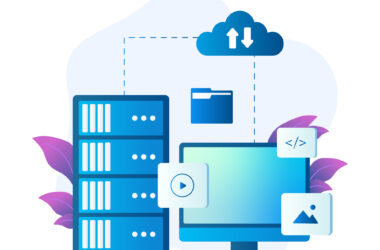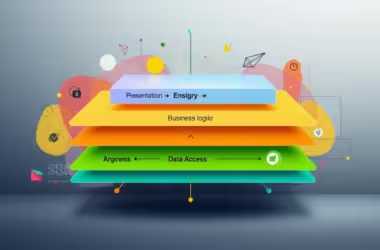Scalability is key in today’s tech world. It’s because demands on tech are growing fast. Designing scalable software architectures helps systems handle more users, more data, or more complicated tasks easily. This ability is vital. It keeps systems running smoothly and ensures they can manage more work when needed.
There are some main ideas to make a system scalable. These include breaking the system into smaller parts, adding resources easily, processing tasks separately, splitting data, and spreading the system across different areas. These steps are crucial for a system that can grow. Focusing on scalability is important. It helps applications handle more users and reach more places without trouble.
Key Takeaways
- Scalability is critical for modern software design to handle increased demands efficiently.
- Scalable architectures ensure performance and reliability during high traffic peaks.
- Core principles include modularity, horizontal scaling, and asynchronous processing.
- Data partitioning and geographic distribution help distribute system loads evenly.
- Planning for scalability from the outset ensures long-term application success.
Introduction to Scalable Software Architectures
Today, scalable software design is crucial. The rise of increasing users and more data demands strong systems.
For a software to succeed, thinking ahead and planning is key. These plans help handle sudden user increases and guarantee reliability. They must also manage more data without losing speed.
Companies do well with scalable designs by being flexible and modular. This way, they can support more users without extra costs.
Using scalable designs boosts performance and dependability. It keeps systems stable during high traffic. Scalability means being ready for future hurdles with ease.
Core Principles of Designing Scalable Systems
Designing scalable systems is based on key principles. These ensure strong performance as demands grow. They help in improving speed, organizing data well, and keeping systems reliable. Let’s explore these important ideas.
Modularity
Modularity is crucial for scalable systems. It means making system parts less dependent on each other. This method lets you update or grow parts without impacting the entire system.
Horizontal Scaling
Horizontal scaling means adding more machines, not just upgrading current ones. It makes the system more flexible and scalable. This is key for handling high demand efficiently.
Asynchronous Processing
Asynchronous processing helps in improving speed. It separates tasks from direct requests. This way, the system can manage more work without slowing down.
Data Partitioning
Data partitioning involves spreading data across several servers. This balances the workload. It’s crucial for managing lots of data and users smoothly.
Geographic Distribution
Geographic distribution places system parts in different locations. This improves speed and dependability for users worldwide. It ensures quick access and keeps the system strong during local outages.
Using these principles is key to making systems that work well and can grow over time.
Four Key Dimensions of Scalability
Scalability is about four key aspects: load, storage, space, and how we manage it all. Each part is crucial for coping with growth, while keeping systems reliable and fast.
Load Scalability
Handling more visitors smoothly is what load scalability is all about. It means preparing for high traffic by adding more resources. This way, websites run smoothly, even when lots of people visit at once.
Storage Scalability
As data grows, we need more room for it. That’s where storage scalability comes in. It’s about splitting up and replicating data across different places to keep things running fast.
Space Scalability
Space scalability lets systems grow to cover more ground. It’s vital for serving users worldwide. This ensures fast, efficient service, no matter how complex or far-reaching the system becomes.
Administrative Scalability
Keeping systems easy to manage, even as they expand, is the goal of administrative scalability. It’s about adding new parts without making things too complicated. Keeping systems simple to use is key to their success.
Mixing these areas when we build big systems is important. This helps them handle more work and users over time, without losing speed or quality.
Strategies for Achieving Scalability
Making software scalable is key to managing more users and keeping performance high. By using different methods, developers can make systems faster and more reliable for users.
Horizontal Scaling
With horizontal scaling, you can add more computers to handle bigger workloads. This method offers flexibility and reduces the risk of the system failing. It makes growing easier without having to redo everything.
Caching
Caching helps lessen the demand on databases and makes systems respond quicker. Storing common data in memory lets systems deliver content fast. This improves how well the system works and makes it more efficient.
Asynchronous Processing
Asynchronous processing separates tasks from direct user actions. It allows handling tasks in queues without stopping other processes. This way, systems can do more at once and reduce delays, which is crucial for scaling.
Sharding
Sharding breaks up a big database into smaller parts. By spreading data across several servers, it greatly lowers database reduction latency. This helps systems grow with demand from users.
Geo-distribution
Geo-distribution puts servers closer to users to speed up performance. It cuts down delay and avoids too much data traffic. This method keeps systems close to users for a smoother and more dependable service, especially worldwide.
In summary, these strategies help make your software architecture scalable. They prepare it to handle growing numbers of users successfully.
Designing Scalable Software Architectures for the First 100 Million Users
To handle 100 million users, creating a scalable software architecture is key. This includes focusing on prepare scalability, adopting horizontal scaling, and using flexible data models for sharding. With these steps, the architecture can smoothly adjust as more users join.
System high availability is also crucial. This means adding redundancy to avoid single points of failure. Doing so keeps the service running always. It helps the system handle lots of user adoption without breaking down.
Handling big user numbers isn’t just about speed. It’s about creating a tough system that can bounce back. Early choices in how to scale are vital. They help avoid big problems and expensive fixes later. By sticking to these main ideas, companies can grow their user crowd while keeping a strong, quick-reacting system.
- Horizontal Scaling: Makes managing resources easier and boosts flexibility.
- Flexible Data Models: Makes it easier to shard and balance user load.
- High Availability: Keeps services up with backup systems and designs that can handle faults.
- Minimize Outages: Tries to cut down on downtime for a better experience for users.
As more people use the system, early efforts in making it scalable really pay off. It leads to a reliable and steady software. Thus, putting scalability at the heart of design is a must for long-lasting success in software.
The Critical Role of Cloud Computing in Scalability
Cloud computing has changed how businesses handle growth needs. It lets companies change their tech setup based on current needs. This is key for keeping up with high demand times while saving money when things are slow.
Benefits of Cloud Computing
Cloud computing does more than just help with growth. It saves money, is flexible, and easy to start. Unlike old tech setups, cloud services can grow in any direction, up or out, anytime. This means businesses can meet specific needs fast and without waste.
Case Studies
Netflix shows how well cloud computing works. They use the cloud to handle lots of users and stream videos worldwide smoothly. The cloud lets Netflix focus on sharing content, without old tech limits.
Many companies see similar benefits from the cloud. For example, different industries use it to get past growth limits and work better. These success stories show that cloud computing is crucial for growth today. It’s a must-have for modern businesses.
Service-Oriented Architecture and Microservices
Service-Oriented Architecture (SOA) and microservices are key for building scalable systems. They help systems scale and make maintenance easier. Distributed systems and containerization work well with these paradigms, making resource use efficient.
Benefits of SOA
SOA lets businesses organize around services. This setup allows for teams to work independently on development, testing, and scaling. It’s flexible, adapting quickly to new business or tech changes.
SOA also links different systems well. It creates a durable and flexible environment that meets various needs.
Microservices
Microservices build on SOA, splitting applications into smaller services that deploy independently. They use containerization, minimizing clashes over resources. This supports distributed systems and easy scaling.
They also allow for fast updates and deployments. This makes software development more agile and efficient.
- Independent Scaling: Different parts of an application can scale independently, improving resource utilization.
- Resilience: Fault isolation in microservices ensures that a failure in one service doesn’t bring down the entire system.
Ensuring Fault Tolerance within Scalable Systems
Building resilient systems requires careful planning. It includes setting up protections to keep the system safe as it grows. Circuit Breakers and Bulkheads are key to avoiding failures when under heavy load.
A resilient architecture needs a well-thought-out design. It must be ready for possible system overloads. By using Bulkheads, we create separate areas in the system. This keeps problems in one area from affecting the whole system. It’s a crucial step for keeping the system reliable.
Circuit Breakers serve as a safety net. They stop processes that might fail, preventing further issues. This helps the system stay stable and bounce back quickly. It’s important for keeping services running smoothly and users happy.
Adding these tactics is key to robust fault tolerance in growing systems. It makes sure the system can handle more load. It also stays reliable and efficient.
Conclusion
Having a growth-focused architecture is key to creating strong and long-lasting software systems. With technology needs growing fast, scaling these systems is very important. It’s not just a tech decision but a vital plan for success. By starting with scalability in mind, developers make sure their apps can take on more users and data easily.
Planning for scalability leads to lasting performance and dependability. When designs include scalability from the start, systems grow smoothly with increasing demands. This forward-thinking avoids crashes during high user traffic and aids in expanding to new areas.
In sum, scalable software is crucial for scaling businesses. Organizations that consider how to scale, like using modules, spreading out data, and more, will do well. They can face tech advances without big changes. This keeps them stable and ready for what’s next.






